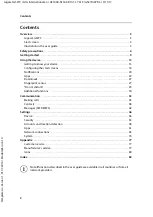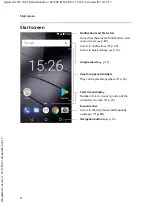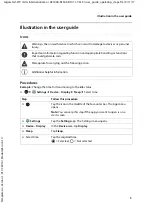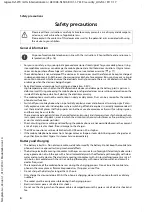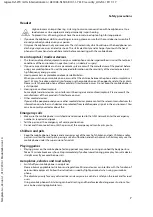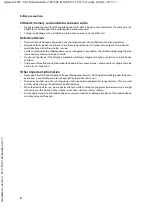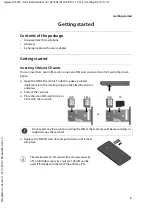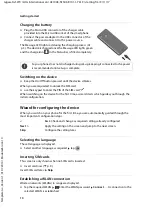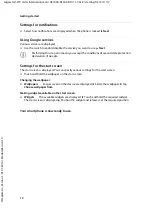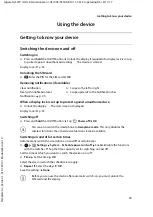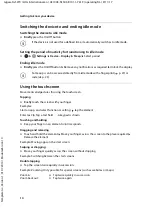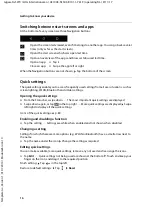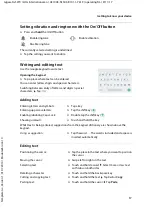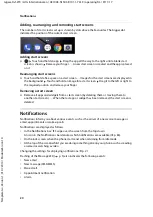
6
Te
mplat
e
G
o
, V
e
rs
ion 1
, 01.
07
.2
014
/ M
odu
leV
e
rs
ion 1
.0
Safety precautions
Gigaset GS270 / LUG International en / A31008-N1503-R101-1-7619 / security_LUG.fm / 9/11/17
Safety precautions
General information
•
For your own safety, only use original, approved accessories from Gigaset for your mobile phone. Using
incompatible accessories can damage the mobile phone and entail hazardous situations. Original acces-
sories can be purchased from Gigaset Customer Service (see Customer service (
•
The mobile phone is not waterproof. The device or its accessories must therefore not be kept or charged
in damp environments (in bathrooms, shower rooms or kitchens, for example). Rain, moisture or any liquid
can contain minerals which can cause the electrical circuitry to corrode. There is a risk of electric shock, fire
or damage when the device is being charged.
•
Permitted temperature range for charging and operation: 0-40°C.
High temperatures can shorten the life of electronic devices and damage the battery; plastic parts can
deform or melt. Using or keeping the mobile phone in refrigerated areas can result in condensation on the
inside of the telephone which will destroy the electronic circuitry.
•
The mobile phone must not be used or kept in dusty or dirty places. Dust can be a reason for the mobile
phone to malfunction.
•
Switch off your mobile phone when in potentially explosive areas and observe all warning signs. Poten-
tially explosive areas also include places where switching off vehicle engines is normally recommended. It
is at these kinds of places that flying sparks can be the cause of explosions or fires with resulting injuries,
and there may be a risk to life.
These areas include petrol stations, chemical factories, transport and storage systems for hazardous chem-
icals, spaces under ship decks, areas in which the air contains chemical substances or fine particles (such
as dust or metal powder particles).
•
Short-circuiting, disassembling and modifying the mobile phone are not permitted because they present
a risk of injury, electric shock, fire or damage to the charger.
•
The USB connection must be established with USB version 2.0 or higher.
•
If the mobile telephone becomes hot, changes colour or shape or leaks whilst being used, charged or at
any other time, contact Gigaset Customer Service immediately.
Battery and charging
•
The battery is built-in. Do not disassemble, weld and/or modify the battery. Do not keep the mobile tele-
phone where it is exposed to strong mechanical effects.
•
The battery electrolyte coming into contact with eyes can cause a loss of eyesight. If electrolyte does enter
an eye, please do not rub the eye with a hand. Immediately wash the affected eye thoroughly with clear
water and consult a doctor. The electrolyte coming into contact with skin (or clothing) presents a risk of
skin burns. Immediately wash the skin or clothing thoroughly with soap and clear water, and consult a
doctor if required.
•
The temperature of the mobile phone rises during the charging process. Do not store the mobile tele-
phone in the same place as flammable products as this poses a risk of fire.
•
Do not charge the battery for longer than 12 hours.
•
Only charge the device indoors. Whilst the phone is charging, do not use the phone for calls or dial any
numbers.
•
The socket must be easily accessible during the charging process.
•
Electrical storms pose a risk of electric shocks.
•
Do not use the charger when the power cable is damaged because this poses a risk of electric shock and
fire.
Please read these instructions carefully. Failure to comply presents a risk of injury and damage to
a device, as well as breaches of applicable laws.
Please explain the contents of this document as well as the potential risks associated with using
this device to your children.
Dispose of used mobile telephones in line with the instructions (Chapter Waste and environmen-
tal protection (


